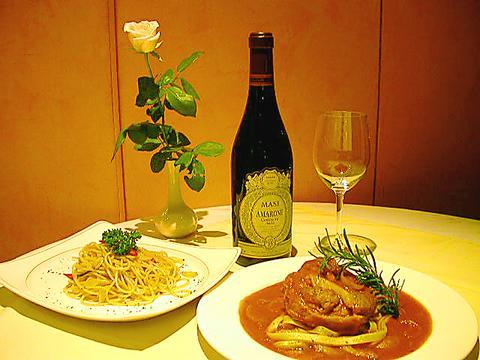Having spent 13 years studying French and Italian cuisines in Vienna, there's hardly any dish that Hong Chang-wei (
A college restaurant management lecturer in the daytime, the chef and owner of Sowieso maintains gourmet-standard cuisine at his restaurant, as well as introducing Italian dishes rarely available here.
When Hong returned to Taiwan from learning his trade in Austria and Italy nine years ago, he set up one of the few Taipei restaurants that offered more kinds of pastas than spaghetti.

PHOTO: VICO LEE, TAIPEI TIMES
Hong's love for Italian cuisine was born from his first savoring of spaghetti with peppers and garlic in Vienna. "Before I went to Vienna, like most people in Taiwan at the time, my idea of pasta was nothing more than spaghetti with pork and sauce. The spaghetti with peppers and garlic made me understand the essence of good Italian cuisine. The noodles were bouncy and the olive oil wrapped around the noodles so closely it became one. Also the garlic slices blended into the oil, so that the fragrance lingered," Hong recounted.
"Italian cooking is very similar to Chinese cooking. There's sauteeing, stir-frying, boiling and stewing. The preparations of ingredients are also similar," Hong said.
Hong's version of spaghetti with peppers and garlic (spaghetti alio e olio, NT$280) is made with basil leaves and chili peppers. It is slightly different from the authentic version, not to create a localized flavor, but to improve the fragrance and flavor. It's mainly the foreign customers, Hong said, who most fully appreciate the restaurant's authentic cooking style. Osso bucco alla milanese with fettuccine (NT$680) is their favorite, he said.
Apart from using quality ingredients, Hong said the secret of good cooking was often the use of spices and treatment of ingredients before they are cooked. Simple ingredients can also work magic if prepared right, Hong said. The pumpkin soup, for example, acquires a delightful color and aroma after the pumpkins are left to ripen for a few days to bring out their sweetness.
Wines are Sowieso's forte. The restaurant has a regular stock of over 60 kinds of wines from seven countries, mostly Italy, France and Spain. Hong chose Farnese's 2000 Chardonnay to go with the spaghetti, peppers and garlic. For the fettuccine he selected Masi's Amarone 1997.

In Taiwan there are two economies: the shiny high tech export economy epitomized by Taiwan Semiconductor Manufacturing Co (TSMC, 台積電) and its outsized effect on global supply chains, and the domestic economy, driven by construction and powered by flows of gravel, sand and government contracts. The latter supports the former: we can have an economy without TSMC, but we can’t have one without construction. The labor shortage has heavily impacted public construction in Taiwan. For example, the first phase of the MRT Wanda Line in Taipei, originally slated for next year, has been pushed back to 2027. The government

July 22 to July 28 The Love River’s (愛河) four-decade run as the host of Kaohsiung’s annual dragon boat races came to an abrupt end in 1971 — the once pristine waterway had become too polluted. The 1970 event was infamous for the putrid stench permeating the air, exacerbated by contestants splashing water and sludge onto the shore and even the onlookers. The relocation of the festivities officially marked the “death” of the river, whose condition had rapidly deteriorated during the previous decade. The myriad factories upstream were only partly to blame; as Kaohsiung’s population boomed in the 1960s, all household

Allegations of corruption against three heavyweight politicians from the three major parties are big in the news now. On Wednesday, prosecutors indicted Hsinchu County Commissioner Yang Wen-ke (楊文科) of the Chinese Nationalist Party (KMT), a judgment is expected this week in the case involving Hsinchu Mayor Ann Kao (高虹安) of the Taiwan People’s Party (TPP) and former deputy premier and Taoyuan Mayor Cheng Wen-tsan (鄭文燦) of the Democratic Progressive Party (DPP) is being held incommunicado in prison. Unlike the other two cases, Cheng’s case has generated considerable speculation, rumors, suspicions and conspiracy theories from both the pan-blue and pan-green camps.

Stepping inside Waley Art (水谷藝術) in Taipei’s historic Wanhua District (萬華區) one leaves the motorcycle growl and air-conditioner purr of the street and enters a very different sonic realm. Speakers hiss, machines whir and objects chime from all five floors of the shophouse-turned- contemporary art gallery (including the basement). “It’s a bit of a metaphor, the stacking of gallery floors is like the layering of sounds,” observes Australian conceptual artist Samuel Beilby, whose audio installation HZ & Machinic Paragenesis occupies the ground floor of the gallery space. He’s not wrong. Put ‘em in a Box (我們把它都裝在一個盒子裡), which runs until Aug. 18, invites